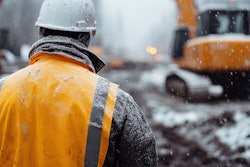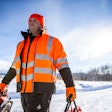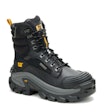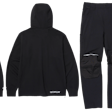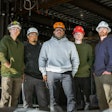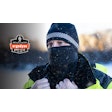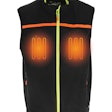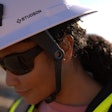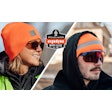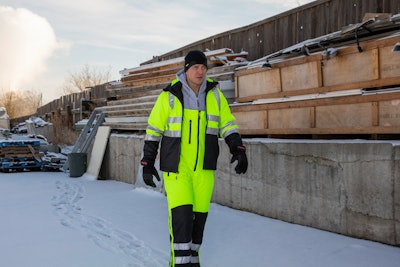
Through blazing summer heat or blustery winter winds, construction crews are at the mercy of Mother Nature year-round.
Workwear and safety gear built for cold weather make all the difference in staying protected from weather-related illnesses and injuries. Still, crews need gear that keeps them protected without being in the way of getting the job done.
Why Construction Workers Need Cold Weather PPE
Because construction crews are often working at height and exposed to the elements, they are particularly vulnerable to cold stress.
Cold stress occurs when the body draws blood away from the extremities to maintain warmth in the vital organs. It can occur even in relatively mild conditions, such as when temperatures are around 50°F and wind or rain is present.
Without proper safety precautions and protective workwear, cold stress can induce fatigue, drowsiness, disorientation and delayed reaction times in construction workers. It can also result in frostbite, hypothermia and other cold-related injuries that jeopardize safety on the job site.
How to Choose the Warmest Safety Workwear for Winter
Even though the Occupational Health and Safety Administration (OSHA) does not yet have a specific standard for outfitting construction crews in cold temperatures, Section 5(a)(1) of the Occupational Safety and Health Act of 1970 requires that employers provide “a place of employment which is free from recognized hazards, including winter weather-related hazards, which are causing or are likely to cause death or serious physical harm to them.”
Employers can follow the simple tips and best practices below for choosing cold weather personal protective equipment (PPE) to keep their crews protected and productive all winter.
Base Layers from the Foundation of Warmth
In its NIOSH Science Blog, the Centers for Disease Control recommends dressing in layers to prevent cold stress in construction workers exposed to cold weather.
To prevent a dangerous buildup of sweat and moisture against the skin, start with a moisture-wicking base layer. Choose long johns and undershirts made with hollow synthetic fibers that wick moisture and channel it away from the skin, rather than cotton layers that absorb moisture and make workers feel colder.
Next, add a mid-layer, such as a thermal hoodie to insulate the arms and torso and lightweight pants to protect the legs. This layer creates an air pocket that prevents body heat from radiating away so quickly.
High-visibility work jackets and pants. The outer layer should meet safety standards for high-visibility fabrics and reflective accents that keep construction workers visible on high-traffic job sites, reducing the risk of accidental injury from passing vehicles or equipment.
The outer layer should also be weatherproof to guard against wind, rain, sleet, and snow if such precipitation is expected. Look for high-visibility jackets and work pants made with wind- and waterproof fabrics, such as coated polyester or polyester with an inner weatherproof membrane. In addition to providing protection from the elements, these materials add durability against wear and tear on the job.
Choosing the correct level of insulation in thermal outerwear will prevent over-bundling, which can limit the range of motion, increase fatigue, and increase the risk of cold stress. It’s safer and more comfortable to choose the lightest possible safety wear to suit the temperature, humidity, and wind chill, as well as the level of activity of each construction worker on the job site.
Choose gear with less insulation for highly active workers generating body heat, such as those shoveling snow. For work that requires less movement and generates little body heat, such as flagging traffic or operating equipment, choose more heavily insulated safety outerwear.
Construction crews will also get more consistent warmth and long-term durability by selecting insulated safety wear made with synthetic insulation. Natural materials, such as wool and down, become uncomfortably heavy when wet and settle into clumps with regular wear and washing, leaving “cold spots” in the garment. Synthetic insulation, such as polyester or recycled and plant-based materials, is lighter, resists moisture and can easily be sewn into place to prevent settling even with heavy and prolonged use.
Safety toe work boots. Slips, trips, and falls create a constant risk of injury on construction sites. Choosing insulated work boots with non-slip soles specially formulated for walking on slick, frosty, or icy surfaces can protect workers from fall injuries.
Construction workers should choose waterproof work boots with outsoles bonded, rather than sewn to the upper. Bonded work boots have fewer points that could allow moisture to seep in. Whenever possible, choose boots with synthetic uppers of Kevlar or nylon. These materials don’t require frequent conditioning, whereas leather boots require frequent treatments or oiling to maintain a waterproof barrier.
Finally, it’s important to select boots with composite safety toes, rather than steel or aluminum, because metal safety toes conduct cold from the ground into the feet, putting workers at risk for developing frostbite in the toes.
Insulated work gloves. Working construction during the winter is like playing a brutal game of bloody knuckles with the cold.
Choose insulated work gloves suited to the conditions on the job site and the work being performed. Some glove manufacturers conduct thermal testing to determine a range of temperatures against which a work glove can protect. Look for these temperature ratings in the glove's description or labeling, and decide if that range matches the conditions on the job site.
Then, consider the work and how much flexibility or dexterity is needed. For intricate work, choose a glove with individual side gussets sewn between each finger for maximum flexibility. An insulated leather mitt will feel warmer in jobs requiring less dexterity, such as hauling lumber.
Next, consider any required safety features. Construction workers at risk for impact injuries may need thermal work gloves made with abrasion-resistant materials, such as leather and heavy-duty polyester, plus impact-protection pads across the back of the hands and knuckles to guard against accidental bangs and pinches.
For maximum warmth and comfort without risking hand fatigue or repetitive motion injuries in cold weather, choose an insulated work glove with a pre-curved, ergonomic fit and flexible material that won’t waste grip strength on forcing an overly stiff glove to bend. For added durability, look for winter work gloves constructed with Kevlar thread and reinforced thumb and palm patches that stand up to handling rough or abrasive construction materials.
Thermal headwear for hard hats. Requiring a hard hat on the job site is standard practice. Allowing the addition of a thermal skull cap, mask, or balaclava should also be standard practice for protecting construction workers’ faces, ears and heads from the risk of frostbite.
If the hard hat or safety helmet provides an inner adjustable fit, simply add a low-profile beanie or full-face mask under it. If the safety headwear doesn’t allow for an extra layer under the hat, look for a hard hat balaclava designed with an extra opening to accommodate the brim and wear it over the required safety helmet or hard hat.
Keep Construction Crews Protected and Productive
Construction crews put themselves at risk every time they step onto the job site, especially during harsh winter weather. Employers can promote job site safety by recommending or supplying insulated PPE that keeps crews warm, safe, and productive all winter.




